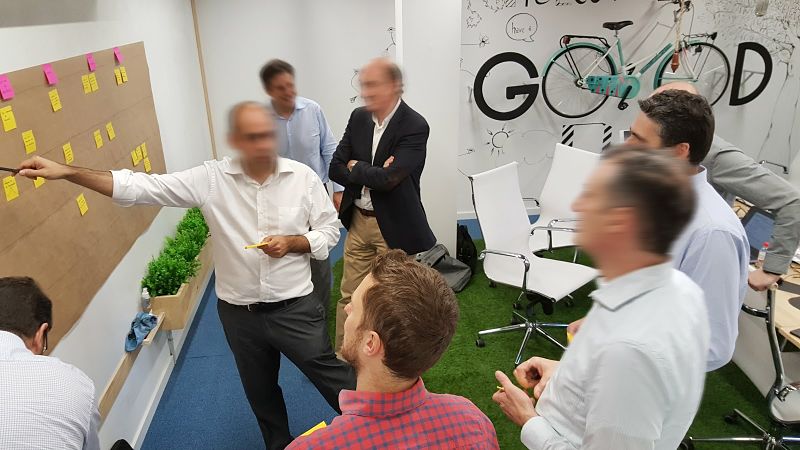Group dynamics sessions are an essential tool in my daily professional life. I use them to design products and services, to generate new ideas, to solve problems... The more I work with them (both as a moderator and as a participant), the higher my opinion of them. Thus, I recommend using them.
The results obtained from a session are mind-boggling. The result of teamwork is much more creative and productive, and the time saved by holding a group dynamics session instead of doing individual work is significant.
But not only that: holding this type of sessions helps to motivate the people who take part in them by taking them outside their routine and giving them a place where their contributions will be heard. Furthermore, they will spend more time with their co-workers.

However, I am now detecting a certain amount of pushback to working with dynamics. Some months ago, when I arrived at a client’s to hold a group dynamics session I found both people who were eager to try new ways of working and the usual sceptics who were nevertheless open to trying the method.
The result of all the sessions was always positive; many ideas and solutions to problems came out of them, agreements were reached, a lot of work was done in a single session… The participants left satisfied; they had taken part in something useful and they knew what to do next.
Lately I have not seen the same predisposition. Now, when I enter a room the atmosphere is not as good because many of the people in attendance have already been in other similar sessions before where the results were not as expected – most likely because they were not held properly.
Dynamics are not witchcraft; if they are not properly moderated, if the correct dynamic is not chosen and, above all, if the results are not followed up on, the group dynamics session loses all of its value.
For example, what good is it to select ideas for evolving the business if nothing is done with them later on and they remain on the post-it note stuck to the board?
So it is now that our job is more important than ever; we have to manage to get attendees involved in the group dynamics session and turn it into something useful in order for them to trust in the method again.
How can a group dynamics session become useful?
A group dynamics session has to be useful and achieve its goal. The moderator of the session is the person who has to guide participants in order for this to happen (and to make them want to repeat).
Below I have listed some tips to make a group dynamics session useful:
- It is essential to choose the attendees well. They have to form a multidisciplinary team which can provide different points of view and includes people with decision-making abilities. Thus, the final result will be fuller and sponsored.
- Know the preliminary context. There is a wide ranging catalogue of dynamics that have a clear purpose. The thing is to select the one that is best suited to each case. However, the needs of the client or the team which will do the work might be different; this might require some tinkering or even creating an ad-hoc group dynamics session. Of course, any time a new group dynamics session is created, it must be tested before being put into practice.
- Rehearse the session well with the team that is going to moderate it and keep some ideas up your sleeves to kick start the process if the brainstorming stalls.
- Resolve the logistical issues before the session takes place. In order to make the most of the time available in the session, prepare all the material you will need to hold it the days leading to it and make sure the room where it will take place is big enough and has all necessary equipment.
- Explain in detail what the group dynamics session is about, the rules of the game and, particularly, its purpose to get everybody aboard the session.
- Avoid discussions or matters that have nothing to do with the goal of the session. It is our job to detect them and cut them short. Nevertheless, since it can be very frustrating for attendees to detect a problem and then see that it is left unresolved, it might be useful to write down the issue on a sticky note and discuss it at the end of the session or in a different session.
- Save some time before the end to draw conclusions and outline the next steps. There is nothing more frustrating than working on something that does not come to anything. Thus, leaving some time before the end to outline the next steps or even appointing people to be in charge of them can be a boost that will ensure the work is continued in the future.
How to turn an attendee into a participant
The conductor is always responsible for getting the attendees involved in the session regardless of their predisposition.
However, now that the trend among clients seems to be being blasé about dynamics, our job is more important than ever.
Here are some suggestions to get attendees to participate and collaborate:
- Again, choosing the right team is crucial. Discard anybody who does not want to actively take part or has to attend for political reasons. If you know beforehand the team with which you are going to work, it will be easier for you to choose the participants that can contribute the most to this kind of session. However, if it is the first time you work with a certain team, it is good to meet first with your contact at the company to work on these things.
- In a group dynamics session all opinions have the same value. This is why it is important to find out who are the people who interrupt proceedings continually, the people in charge who do not let their co-workers speak, the people who impose their opinion on others, etc. To prevent this, the best thing is for there to be more than one person observing and moderating the teamwork to cut short impositions and encourage those who are shier to take part.
- Distribute the teams well. When in a group dynamics session people have to work in pairs or be divided into groups, distributing them properly can be essential to its success. The ideal thing is to put together people who usually do not work together or who do not have a direct hierarchical relationship. In addition, changing the distribution of the teams during the session can help to solve participation issues.
- Avoid distractions. Participants need to be focused so that ideas may flow, so interruptions must be kept down to an absolute minimum. A basic thing is for them to leave their mobiles and computers outside, although it could also be useful to get the participants out of their offices and thus prevent other people from interrupting them.
- Use the room and the time in your favour. In order to be productive one has to be well rested. Therefore, holding group dynamics sessions first thing in the morning will be conducive to having a good result, as well as taking breaks every 2 or 3 hours to recharge batteries.
- Surprise attendees. There is no better way to get the attendees’ attention than to show them something new and different. Be creative with the sessions: take attendees outside their habitual context; if they are tired of post-it notes, design a session without them, with manual objects or with no things; change rooms, offices, materials, moderators, and so on.
Conclusion
Working with dynamics is useful and productive. Nevertheless, it is also true that they do not work by themselves; their success depends on the participants and, especially, the organizers, since it is up to them to help the team to reach the goal of the session.
Comments are moderated and will only be visible if they add to the discussion in a constructive way. If you disagree with a point, please, be polite.





Tell us what you think.